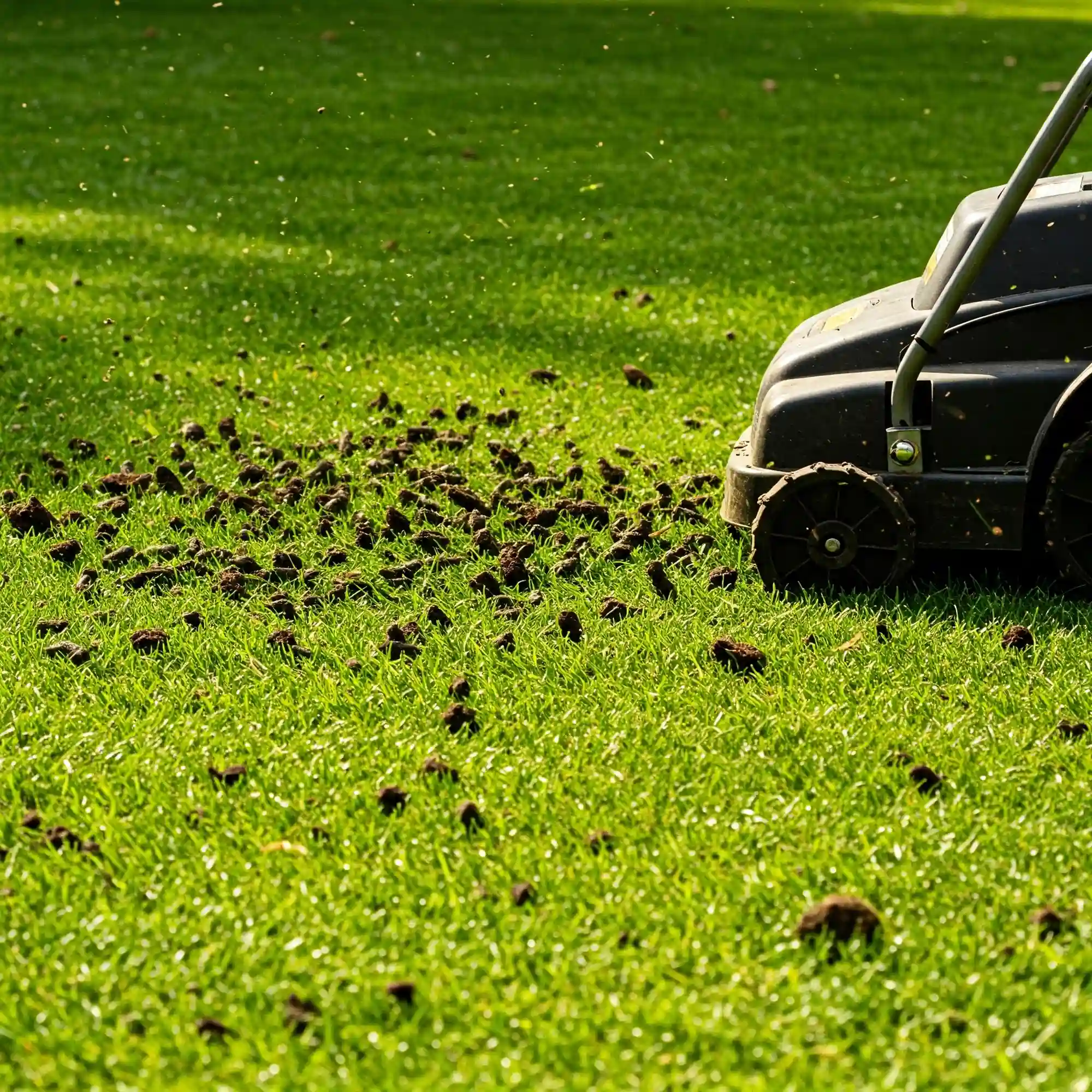Are you looking out at a patchy, dull lawn after a long winter, wondering how to bring it back to life? It’s frustrating, isn’t it, seeing the signs of winter damage when you’re longing for that vibrant green carpet? You’ve probably tried various quick fixes, but nothing seems to truly revive your lawn. Well, you’re not alone, and I’m here to guide you through the essential steps to transform your lawn with effective spring lawn care tips. This is the time to act, and together, we’ll ensure your lawn thrives.
1. Clear Winter Debris and Prepare the Lawn
As the days lengthen, and the warmth returns, our lawns awaken too. This is the crucial time to implement Spring lawn care tips, to ensure a vibrant green expanse throughout the growing season. Let’s delve into the essential steps to revive your lawn after its winter slumber.
Winter can leave a mess of debris scattered across your lawn. Leaves, twigs, and dead grass can suffocate new growth and create an environment for pests and diseases. The first step in effective spring lawn care is a thorough cleanup. I begin by using a sturdy rake to gather all the loose debris. This not only improves the appearance of your lawn but also allows sunlight and air to reach the soil, which is vital for healthy growth.
I’ve found that using a leaf blower can be incredibly efficient for larger lawns. However, be mindful of blowing debris into garden beds or neighboring properties. Once the surface debris is cleared, I focus on removing any matted-down dead grass, known as thatch. A light raking can help loosen this thatch, but for thicker layers, a dethatching rake or a powered dethatcher might be necessary.
Why is this step so crucial? Well, think of it like this: your lawn needs to breathe. A layer of debris or thick thatch prevents air, water, and nutrients from reaching the soil and roots. By clearing this barrier, you’re setting the stage for healthy growth.
Tools for Effective Cleanup:
- Rake: A sturdy leaf rake for gathering leaves and light debris.
- Leaf Blower: For efficient cleanup of larger areas.
- Dethatching Rake: For removing thicker layers of thatch.
- Powered Dethatcher: For large lawns with heavy thatch buildup.
- Garden Gloves: To protect your hands during cleanup.
Benefits of Clearing Debris:
- Improves air circulation and sunlight penetration.
- Reduces the risk of fungal diseases and pests.
- Prepares the lawn for aeration and fertilization.
- Enhances the overall appearance of your lawn.
Case Study:
In a recent project, I worked with a homeowner whose lawn was covered in a thick layer of pine needles and dead leaves. The lawn was patchy and weak, with visible signs of fungal disease. After a thorough cleanup, followed by aeration and fertilization, the lawn showed significant improvement within weeks. The homeowner was amazed at the transformation, noting the lush green growth and the absence of disease.
Fact:
Removing debris and thatch can improve the effectiveness of fertilization by up to 30%.
This initial cleanup is more than just tidying up; it’s a fundamental step in setting the foundation for a healthy, thriving lawn. By clearing away the remnants of winter, you’re giving your lawn the best possible start to the growing season.
2. How to Test Your Soil pH Before Spring Fertilization
How to test soil pH before spring fertilization, is a crucial step in preparing your lawn for optimal growth. Understanding your soil’s composition allows you to make informed decisions about fertilization.
Before you start applying fertilizers, it’s essential to understand the pH level of your soil. Soil pH affects the availability of nutrients to your grass. If the pH is too acidic or too alkaline, your lawn won’t be able to absorb the nutrients it needs, even if you’re applying the best fertilizers.
Why Soil pH Matters:
- Nutrient Availability: Grass thrives in a slightly acidic to neutral pH range, typically between 6.0 and 7.0. Outside this range, essential nutrients become locked up in the soil and are inaccessible to your lawn.
- Microbial Activity: Beneficial soil microbes, which play a vital role in nutrient cycling, prefer a neutral pH.
- Weed Control: Certain weeds thrive in specific pH ranges. Knowing your soil pH can help you manage weed growth more effectively.
How to Conduct a Soil pH Test:
- Gather Your Tools: You’ll need a soil testing kit, which you can purchase from most garden centers, or you can send a soil sample to a lab.
- Collect Soil Samples: Use a clean trowel or soil probe to collect samples from various spots in your lawn, about 4-6 inches deep. Mix these samples in a clean bucket to create a representative sample.
- Follow Kit Instructions: If using a soil testing kit, follow the instructions provided. These kits usually involve mixing soil with water and a reagent, then comparing the color of the solution to a pH chart.
- Send to a Lab: If sending a sample to a lab, follow their instructions for collecting and packaging the soil. Labs provide detailed reports on your soil’s pH and nutrient levels.
Adjusting Soil pH:
- To Raise pH (Make Soil Less Acidic): Apply lime. The amount of lime needed depends on your soil type and current pH.
- To Lower pH (Make Soil More Acidic): Apply sulfur or aluminum sulfate. Again, the amount depends on your soil type and current pH.
Tips for Accurate Testing:
- Test your soil in multiple locations to get a representative sample.
- Avoid testing immediately after heavy rain or fertilization.
- Follow the instructions on your soil testing kit carefully.
Fact:
A study by the University of Wisconsin-Madison found that adjusting soil pH to the optimal range can increase nutrient uptake by grass by up to 50%.
By understanding and adjusting your soil pH, you’re ensuring that your lawn can effectively utilize the nutrients you provide, leading to healthier, more vibrant growth.
3. How to Aerate and Dethatch Your Lawn for Healthy Spring Growth
How to aerate and dethatch lawn for healthy spring growth, depends on your local climate and your lawns specific needs. These actions assist in promoting healthy root systems.
Aeration and dethatching are two vital spring lawn care practices that go hand-in-hand. They improve soil health, promote deeper root growth, and enhance nutrient and water absorption.
Aeration
Aeration involves creating small holes in the soil, typically using a core aerator that removes small plugs of soil. This process relieves soil compaction, which can restrict root growth and impede water and air circulation. Aeration also helps reduce thatch buildup.
Benefits of Aeration:
- Improved Drainage: Allows water to penetrate deeper into the soil, reducing runoff and preventing waterlogging.
- Enhanced Root Growth: Encourages deeper root development, leading to a stronger, more drought-tolerant lawn.
- Better Nutrient Absorption: Allows fertilizers and other nutrients to reach the root zone more effectively.
- Reduced Thatch Buildup: Helps break up thatch, a layer of dead and decaying organic matter that can suffocate the grass.
Dethatching
Dethatching involves removing the layer of thatch from the lawn. Thatch can build up over time, hindering air, water, and nutrient movement to the soil.
Benefits of Dethatching:
- Improved Air and Water Circulation: Allows air, water, and nutrients to reach the soil more easily.
- Reduced Disease Risk: Reduces the risk of fungal diseases that thrive in thatch.
- Improved Fertilizer Effectiveness: Allows fertilizer to reach the soil more effectively.
- Enhanced Grass Growth: Creates a healthier environment for grass to grow and thrive.
When to Aerate and Dethatch:
The best time to aerate and dethatch your lawn is in early spring, before the onset of hot weather. The soil should be moist but not soggy.
Tools for Aeration and Dethatching:
- Core Aerator: A machine or hand tool that removes small plugs of soil.
- Dethatching Rake: A rake with sharp blades that can remove thatch from the lawn.
- Powered Dethatcher: A machine that uses rotating blades to remove thatch.
Tips for Successful Aeration and Dethatching:
- Water your lawn thoroughly a day or two before aerating or dethatching.
- Aerate and dethatch in different directions to ensure even coverage.
- Water your lawn lightly after aerating and dethatching to help the soil settle.
- Avoid aerating or dethatching when the soil is too wet or too dry.
By incorporating aeration and dethatching into your spring lawn care routine, you can significantly improve the health and vitality of your lawn. These practices, combined with proper fertilization and watering, will help you achieve a lush, green, and thriving lawn throughout the growing season.
4. Effective Spring Lawn Fertilization Schedule for Optimal Green Results
Effective spring lawn fertilization schedule for optimal green results, requires a careful balance of nutrients and timing. Too much or too little fertilizer can negatively impact your lawn’s health.
Fertilization is a vital step in revitalizing your lawn after winter. It provides the essential nutrients – nitrogen, phosphorus, and potassium – that your grass needs for healthy growth. However, it’s crucial to choose the right fertilizer and apply it at the correct time and rate.
Types of Fertilizers:
- Slow-Release Fertilizers: These fertilizers release nutrients gradually over an extended period, reducing the risk of fertilizer burn and providing consistent nourishment to your lawn.
- Fast-Release Fertilizers: These fertilizers release nutrients quickly, providing a rapid boost of growth. However, they require more frequent applications and carry a higher risk of fertilizer burn.
- Organic Fertilizers: These fertilizers are derived from natural sources such as compost, manure, and bone meal. They release nutrients slowly and improve soil health over time.
Creating a Fertilization Schedule:
- Soil Test Results: Use your soil test results to determine the specific nutrient needs of your lawn.
- Grass Type: Different grass types have different fertilizer requirements. Cool-season grasses generally require more nitrogen in the spring, while warm-season grasses may benefit from a pre-emergent fertilizer application in early spring.
- Climate: Adjust your fertilization schedule based on your local climate. In warmer climates, you may need to fertilize earlier in the spring.
Application Tips:
- Apply fertilizer evenly: Use a spreader to ensure even distribution.
- Water thoroughly after fertilization: This helps the fertilizer dissolve and reach the root zone.
- Avoid fertilizing during hot, dry periods: This can increase the risk of fertilizer burn.
- Follow label instructions: Always follow the manufacturer’s recommendations for application rates and timing.
Fact:
Over-fertilizing can lead to excessive growth, which can weaken the grass and make it more susceptible to diseases. It can also harm the environment by polluting waterways.
By following a well-planned fertilization schedule, you can provide your lawn with the nutrients it needs to thrive while minimizing the risk of damage. Remember to choose the right fertilizer, apply it correctly, and adjust your schedule based on your specific lawn’s needs and your local climate.
5. Best Time to Apply Pre-Emergent Weed Control Spring
Best time to apply pre-emergent weed control spring, is crucial for preventing unwanted weeds from sprouting and taking over your lawn. Timing is everything when it comes to effective weed prevention.
Pre-emergent herbicides are designed to prevent weed seeds from germinating. They create a barrier on the soil surface that stops weed seeds from sprouting. To be effective, pre-emergent herbicides must be applied before weed seeds germinate, typically in early spring.
When to Apply:
The ideal time to apply pre-emergent weed control in the spring varies depending on your local climate and the specific types of weeds you’re trying to control. Here are some general guidelines:
- Cool-Season Grasses: Apply pre-emergent herbicides to cool-season grasses (like fescue, bluegrass, and ryegrass) in early spring, typically when soil temperatures reach 50-55°F consistently.
- Warm-Season Grasses: For warm-season grasses (like Bermuda grass, Zoysia grass, and St. Augustinegrass), apply pre-emergent herbicides in late spring or early summer, before the weeds begin to germinate.
Choosing the Right Pre-Emergent Herbicide:
Pre-emergent herbicides are available in a variety of formulations, including granules, liquids, and concentrates. Choose a product that is labeled for use on your specific type of grass and targets the weeds that are prevalent in your area.
Application Tips:
- Read and follow label instructions carefully: This will ensure you apply the herbicide correctly and safely.
- Water the lawn thoroughly before applying the pre-emergent herbicide: This helps the herbicide penetrate the soil more effectively.
- Avoid applying pre-emergent herbicides to newly seeded areas: This can prevent the grass seed from germinating.
- Reapply as needed: Depending on the product and the severity of weed pressure, you may need to reapply pre-emergent herbicide throughout the growing season.
Important Note:
Pre-emergent herbicides can prevent the germination of desirable plants as well as weeds. Avoid applying them near flower beds, vegetable gardens, or other areas where you want to plant seeds.
By applying pre-emergent herbicides at the right time and using them correctly, you can effectively prevent weed problems and enjoy a beautiful, weed-free lawn throughout the growing season.
6. How to Repair Bare Spots in Lawn After Winter Spring
How to repair bare spots in lawn after winter spring, involves several steps to ensure successful regrowth. Proper soil preparation and consistent watering are key to restoring your lawn’s uniformity.
Winter can be tough on lawns, leaving behind unsightly bare patches. These patches can occur due to various factors, including heavy foot traffic, disease, drought, or simply the harshness of winter weather. While it may seem daunting, repairing bare spots is achievable with the right approach.
Preparing the Area:
- Remove Debris: Clear the area of any debris, such as leaves, twigs, and rocks.
- Loosen the Soil: Use a garden rake to loosen the compacted soil in the bare patch. This allows for better seed-to-soil contact.
- Remove Existing Grass: If there are any remaining grass blades in the bare patch, use a sharp knife or a garden trowel to remove them.
Choosing the Right Grass Seed:
Select a grass seed blend that is suitable for your climate and soil type. Consider using a high-quality seed mix that contains a blend of different grass varieties for a more resilient and attractive lawn.
Seeding the Bare Patch:
- Apply Seed Evenly: Broadcast the grass seed evenly over the prepared area. You can use a hand spreader or simply scatter the seed by hand.
- Cover Lightly: Gently rake the seed into the soil to ensure good seed-to-soil contact.
- Water Gently: Water the seeded area lightly and frequently to keep the soil moist but not soggy.
Maintaining the New Growth:
- Water Consistently: Continue to water the newly seeded area regularly, especially during dry periods.
- Avoid Heavy Foot Traffic: Keep pets and children off the area until the new grass has established itself.
- Mow High: Once the new grass reaches a height of 2-3 inches, mow it at a higher setting than usual to encourage deeper root growth.
- Fertilize: Apply a light application of fertilizer after the new grass has established itself.
Tips for Success:
- Repair Bare Spots in Early Spring: This allows the new grass to establish itself before the heat of summer arrives.
- Consider Over-seeding: If you have a few scattered bare spots, consider over-seeding the entire lawn instead of repairing individual patches.
- Consult with a Local Lawn Care Expert: If you’re unsure about the best approach for repairing bare spots, consult with a local lawn care professional.
By following these steps and maintaining consistent care, you can effectively repair bare spots in your lawn and restore its lush, green appearance.
7. Spring Lawn Care Tips for Cool Season Grass Beginners
Spring lawn care tips for cool season grass beginners, requires knowledge of the particular needs of these grass types. Understanding the optimal timing for each task is essential for a thriving lawn.
Cool-season grasses like fescue, bluegrass, and ryegrass thrive in cooler temperatures and go dormant during hot summer months. As a beginner with cool-season grass, it’s essential to understand their unique needs in the spring to ensure a healthy and vibrant lawn.
Here are some key spring lawn care tips for cool-season grass beginners:
- Early Spring Cleanup: Start by removing any debris such as leaves, twigs, and thatch. This allows sunlight and air to reach the soil, promoting healthy growth.
- Soil Testing: Conduct a soil test to determine the pH level and nutrient content. This will help you choose the right fertilizer and make informed decisions about soil amendments.
- Fertilization: Apply a slow-release fertilizer formulated for cool-season grasses in early spring. Follow the recommended application rates on the fertilizer label.
- Aeration: Aerate your lawn to improve air and water circulation, especially if you have heavy foot traffic or compacted soil.
- Overseeding: If you have bare patches or thin areas, overseed with a high-quality cool-season grass seed mix.
- Watering: Water deeply and infrequently to encourage deep root growth. Avoid frequent, shallow watering, which can lead to shallow roots and drought stress.
- Mowing: Mow your lawn at the proper height (usually 2.5-3.5 inches) and avoid scalping. Scalping can stress the grass and make it more susceptible to disease.
- Weed Control: Apply a pre-emergent herbicide in early spring to prevent weeds from germinating. You can also spot-treat weeds with a post-emergent herbicide.
- Sharpen Your Mower Blades: Sharp mower blades cut cleanly, preventing grass from tearing and browning.
By following these tips and paying close attention to your lawn’s specific needs, you can ensure a healthy and beautiful cool-season grass lawn throughout the growing season. Remember to be patient and consistent in your efforts, and don’t hesitate to seek advice from local gardening experts if you have any questions.
8. Spring Lawn Care Tips for Clay Soil and Proper Drainage
Spring lawn care tips for clay soil and proper drainage, are essential to prevent waterlogging and promote healthy root growth. Amending the soil with organic matter can significantly improve its structure.
Clay soil can be challenging to manage, especially in the spring. Its dense nature can hinder water drainage, leading to compacted soil and poor root growth. However, with the right approach, you can create a healthy and vibrant lawn even in clay soil.
Understanding Clay Soil:
- Water Retention: Clay soil retains water well, which can be beneficial during dry periods. However, excessive moisture can lead to waterlogging, which can suffocate grass roots.
- Compaction: Clay soil is prone to compaction, which restricts air and water movement.
- Poor Drainage: Compacted clay soil can impede water drainage, leading to puddles and standing water.
Improving Drainage:
- Aeration: Regular aeration is crucial for improving drainage in clay soil. It creates channels in the soil that allow water to penetrate more easily.
- Amendments: Incorporating organic matter such as compost or peat moss can help improve soil structure and increase drainage.
- Grading: Ensure your lawn is properly graded to allow for proper water runoff. Avoid creating low spots where water can accumulate.
Spring Lawn Care Tips for Clay Soil:
- Avoid Walking on Wet Soil: Walking on wet clay soil can compact it further, worsening drainage problems.
- Water Deeply and Infrequently: Water deeply but infrequently to encourage deep root growth.
- Choose Drought-Tolerant Grass Varieties: Consider planting drought-tolerant grass species that are better suited to clay soil conditions.
- Monitor for Diseases: Clay soil can create an environment conducive to certain fungal diseases. Monitor your lawn for signs of disease and take appropriate action.
Addressing Compaction:
- Core Aeration: Core aerators remove small plugs of soil, creating channels that improve air and water movement.
- Topdressing: Applying a thin layer of compost or sand can help to improve soil structure and reduce compaction.
By addressing the unique challenges of clay soil, you can create a healthy and thriving lawn. Remember to prioritize proper drainage, improve soil structure, and choose the right management practices for your specific soil conditions.
Conclusion:
In conclusion, implementing these spring lawn care tips consistently will lay the foundation for a healthy and beautiful lawn throughout the growing season. Remember that every lawn is unique, so observe your lawn closely and adjust your care practices as needed.
By combining proper preparation, fertilization, and ongoing maintenance, you can transform your lawn from a dull, winter-worn patch to a vibrant, lush green oasis. Enjoy the satisfaction of a well-maintained lawn and the beauty it adds to your outdoor space.
I hope this guide has been helpful. If you have any further questions or encounter specific challenges with your lawn, don’t hesitate to consult with local gardening experts or experienced lawn care professionals. Happy gardening!




